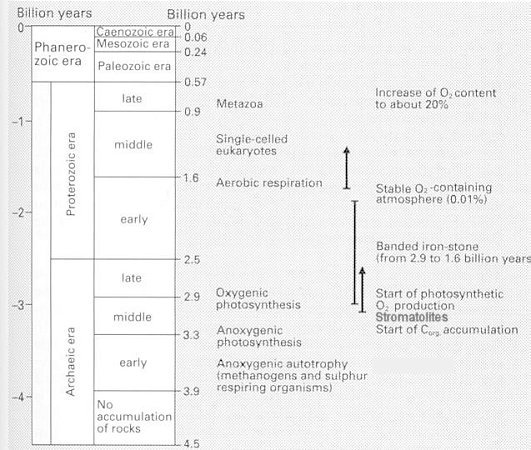
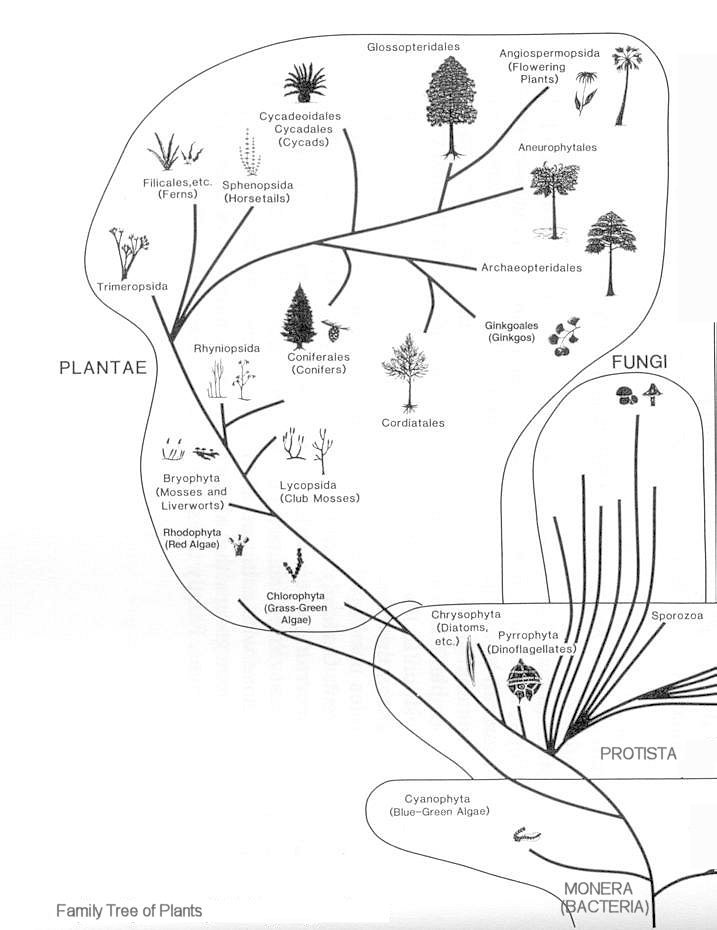
 |
 |
At the time of the appearance of the first organisms about 3.8 billion years ago (see Figure 11-04a), there was no free oxygen, as there is now, but rather a "reducing atmosphere" composed of methane, carbon dioxide, ammonia, and hydrogen (see Figure 11-02a). The microorganisms of this period utilized methane or hydrogen rather than oxygen in their metabolism - they are therefore referred to as "anaerobic" (non-oxygen-using). Fermentation is modern example of anaerobic metabolism. This type of metabolism is 30 to 50 times less effective than oxygen-based ("aerobic") metabolism, or respiration. |
Figure 01 Pre-Cambrian Era [view large image] |
Figure 02 Plants Family Tree [view large image] |
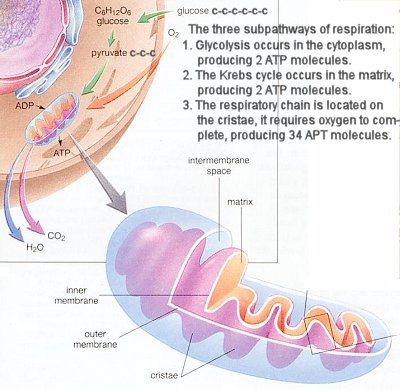 |
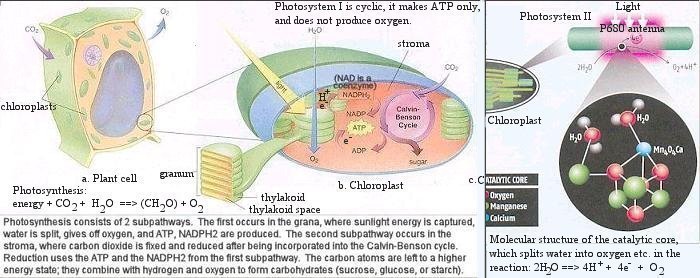 |
Up to 700 MYA, life remained fairly primitive, the distinctions between plants and animals were not very clear-cut. For example, the bacteria (monera) show a variety of forms. Some take in chemicals and depend on atmospheric CO2, like plants (autotrophs - from the Greek autos, self, and trophe, nourishment). Others take in organic material for food, like animals (heterotrophs - from the Greek heteros, other). Some autotrophic |
Figure 03 Mitochond-ria [view large image] |
Figure 04 Chloroplast |
bacteria, called chemosynthetic, do not need light; they obtain their energy from mineral chemical reactions, such as the conversion of sulfur to sulfate or the production of CH4 from CO2 and hydrogen. |
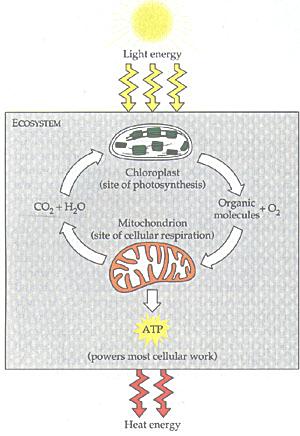 |
Among the multitude of micro-organisms, two bacteria destined to become the major components for the further development of the living world. The mitochondria (see Figure 03) are the sites of the principal oxidation reaction linked to the assembly of ATP, which supplies energy to most of the organisms today. Their closest relative among present-day bacteria have been identified to be the alpha-proteobacteria. The chloroplasts (see Figure 04) are the agents of photosynthesis in unicellular algae and plants. They store the solar energy in the form of glucose (sugar), which becomes food for the "heterotrophs". Their present-day relative are the cyanobacteria (formerly known as blue-green algae), which is believed to be responsible for the first generation of atmospheric oxygen. As shown in Figure 05 the chloroplasts supply food and oxygen for the heterotropic organims, which in turn produced CO2 for photosynthesis. This ecocycle generates a lot of atmospheric oxygen as shown in Figure 11-02 today. The evolutionary steps for the micro-organisms are shown in Figure 01, which shows that the first organisms were anaerobic (anoxygenic) autotrophy. |
Figure 05 Ecocycle |
 |
Another hypothesis proposes that the first organisms were "heterotrophs"; they derived their food from other organisms or organic matter which they were able to consume. Very soon all the available organic matter was exhausted, and life would have cannibalized itself to extinction, were it not for the appearance of a new type of organisms, capable of manufacturing their own food. They are the very early green plants, which were actually an extremely primitive form of algae, similar to the modern blue-green algae, which assume many forms from one-celled to colonial or filamentous (loose association of cells). But the generation of oxygen in the atmosphere started a crisis for the anaerobic organisms, which became either extinct or have to adopt to the new environment. Since then most of the organisms acquire their energy from aerobic metabolism. The organisms evolved into animals captured mitochondria for this purpose. While the plant cells incorporated both mitochondria and chloroplasts to survive. They still retain copy of their own DNA within. The DNAs are in a circular form reflecting their more primitive origin (from the bacteria). |
Figure 06 Blue-green Alage[view large image] |
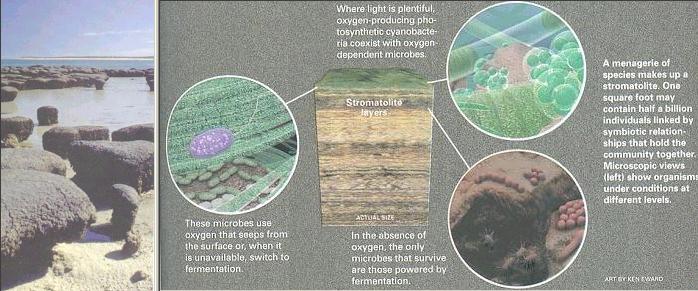 |
Not all of the single-celled organisms of this time were solitary. Beginning around 3 billion years ago, and much more often from 2.3 billion years ago, blue-green algae would often grow in large mats, called Stromatolites (see Figure 07). Modern-day Stromatolites can still be found in a sheltered bay (Shark Bay) in West Australia, where the water is so salty that creatures that would otherwise eat them are not able to exist. |
Figure 07 Stromatolites |
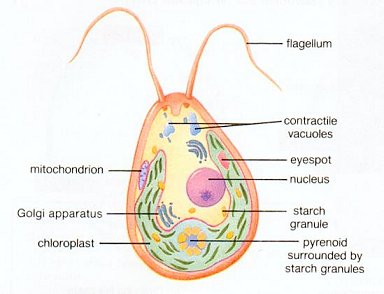 |
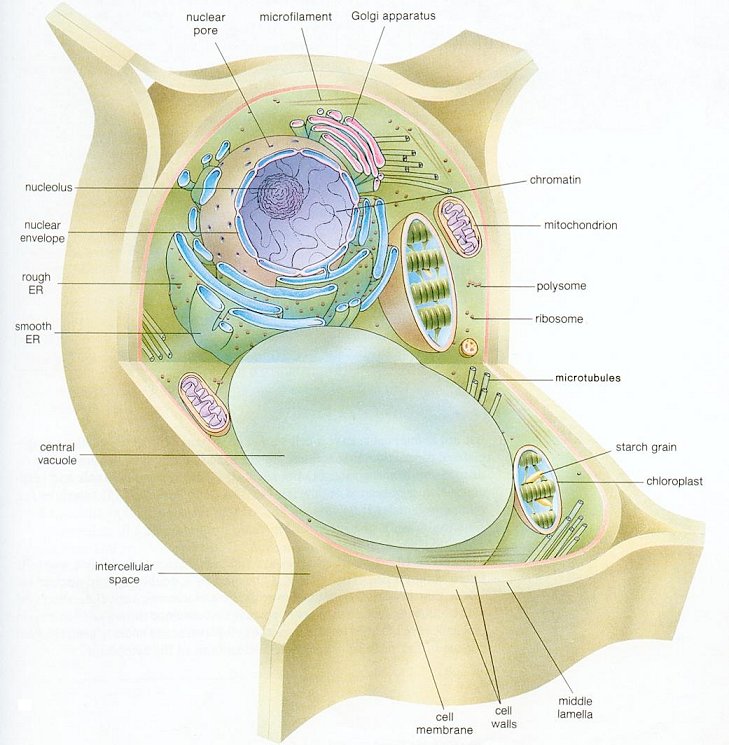 |
Then evolution took another step toward complexity about 1.5 billion years ago. The bacteria acquired a nucleus and advanced to eukaryotic cells (protista). According to one theory, the ancestral eukaryote is envisioned to be the fruit of an early fusion between an anaerobic, thermophilic, and wall-less bacteria, and a motile eubacterium (bacteria with a rigid cell wall). The product of this union inherited from its progenitors the rudiments of what later became the hallmarks of true eukaryotic cells: the genetic core, histones and actin precursors from the archaeon (thermophile), metabolism and propulsion from the eubacterium. |
Figure 08 Green Algae |
Figure 09 Plant Cell |
Subsequent fusion with mitochondria generated cells ancestral to those of animals and fungi. The acquisition of cyanobacteria in yet another round of fusion launched the |
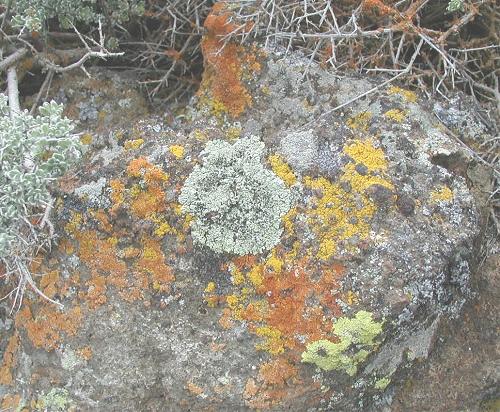 |
 |
on shores, where they practice the ability to digest organic food with excreted enzymes before consuming it. Some fungi cooperate with algae to form a single-organism partnership called lichens (see Figure 10). Figure 11 shows the structure of lichen with the algae under the upper fungal layer. The bodies of the fungi are in the middle in the form of filaments called hyphae. Lichens are able to live on rock, dissolving its minerals and photo-synthesizing food. Lichens, like algae before them experiment with plantlike forms. |
Figure 10 Lichen |
Figure 11 Lichen Structure [view large image] |
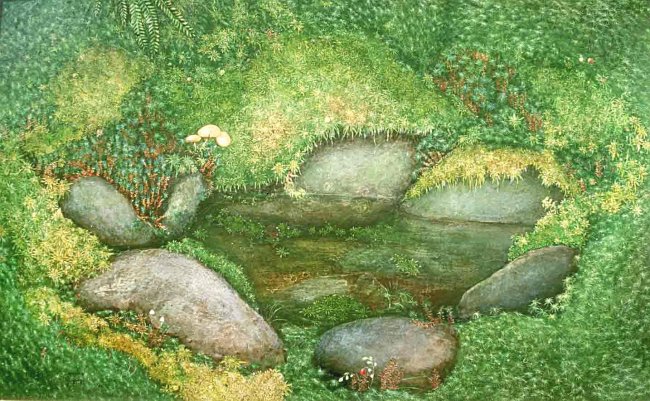 |
Plant cells are more complex than those of either animals or fungi because they have both mitochontria and chloroplasts. The first real plants to evolve are mosses, often found in close association with fungi. From the time they invent a cooperative lifestyle as lichens until today, plants and fungi have a very close association. It may even be that the first plants are a genetic fusion of the two. Ninety percent of plants have fungi called mycorrhizal (root fungus) living in special co-evolved compartments inside their roots or in the soil, intertwined with roots, making food for each other according to specialty and recycling wastes. |
Figure 12 Moss [view large image] |
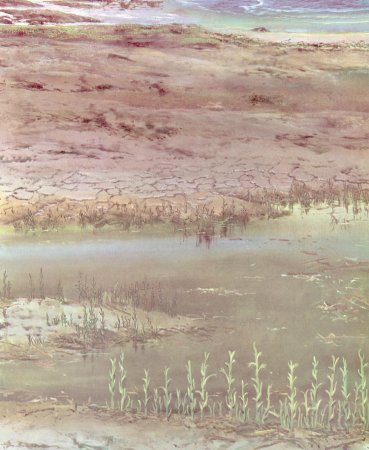 |
It took a long time for plants to develop proper roots and vascular system for land dwelling - tubes or veins to carry water drawn through roots to all parts of their bodies - as well as taller, stiffer bodies that can evolve into ferns and trees. They would evolve ways of reproducing in the absence of water. Like animals, they develop ovaries, producing ova, or eggs, that are fertilized by pollen and develop into embryos within protective bodies. Plants depend on insects for reliable transfers of pollen, while wind, birds, and other animals scatter their fertile seeds. By the Ordovician period, when shallow sea covered large areas of the world, primitive plants such as Boiophyton Pragense had begun to adapt themselves to life on the relatively try land. As shown by Figure 13, Boiophyton had already developed a stiff stem to hold it upright against gravity; equally important, it was vascular - it had developed a system of vessels or tubes to carry water through its body. |
Figure 13 Ordovician Plants [view large image] |
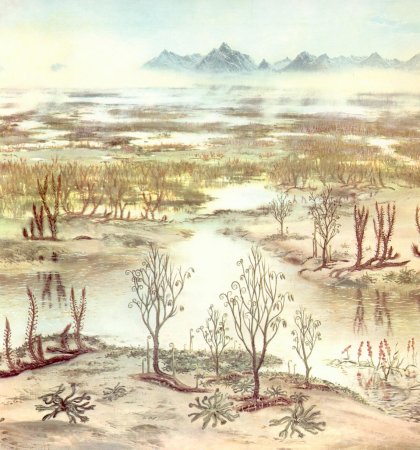 |
Figure 14 shows that at the end of the Silurian period, swamps and marshes beside the sea were already occupied by low vegetation composed of the most primitive types of vascular cryptogams (Psilophytales), plants that reproduce, like fern, by wind-dispersed spores. Some genera were leafless, but others already bore leaves. On the right, in the water, is the Zosterophyllum (a form between ferns and club mosses); to the left of that, on the land, grows the tall Psilophyton, with the low, creeping, spidery Sciadophyton below it. On the left, by the water, is Proto-lepidodendron, the forerunner of the present club mosses, and in the background are clumps of the creeping Drepanophycus, which looked rather like a club moss. |
Figure 14 Silurian Plants [view large image] |
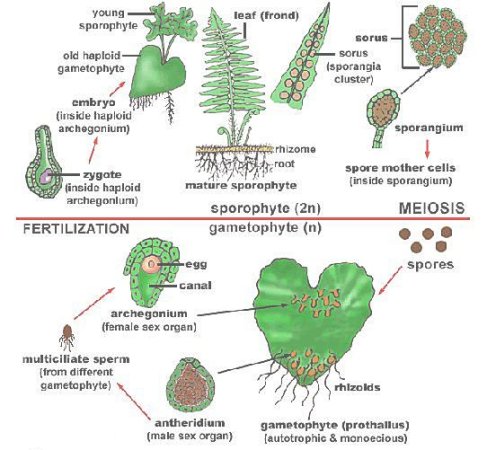 |
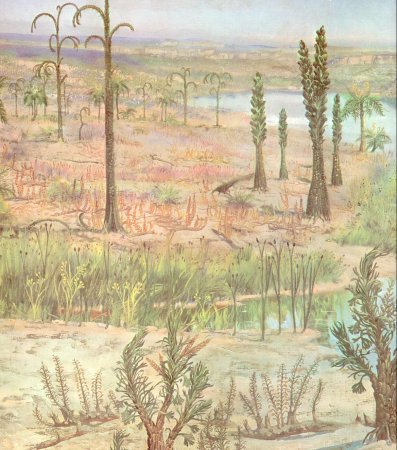 |
Many Devonian plants were seedless. Fern bear interesting traces of their origins. They produce no seeds but rather spore cells that fall to the soil and grow into a peculiar intergeneration plant that is not a leafy fern but a specialized fungu-like form that produces egg cells and sperm cells. Propelled by its whip-like tail, the sperm must swim a short distance through the water of moist soil to fertilize an egg cell from a neighboring plant. The fertilized egg then grows into a mature fern that produces more spores (in the brownish spots on the underside of fern leaves). It is as if the fern is an amphibian plant, growing on land but reverting to water to transmit its gametes. Figure 15 shows the |
Figure 15 Fern Life-cycle |
Figure 16 Devonian Plants |
life-cycle of ferns alternating between the haploid and diploid states. Ferns are one type of seedless plant that has survived since the Devonian. The giant tree fern is still common in tropical regions such as the prehistoric-looking landscapes of Hawaii Volcanoes National Park. |
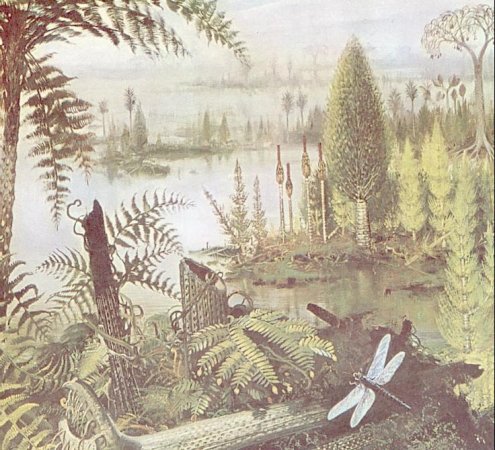 |
During the 30 million years it took to recover the loss, Earth again grew warmer. Hardy mosses and horsetails, that survived to this day, joined with evolving tree ferns, and cordaits to form the first subtropical forests. It is called the Carboniferous period because, over millions of years, succeeding generations of these extensive forests loaded themselves with carbon extracted from the atmosphere. They were gradually pressed into the ground and fossilized as coal and oil. Figure 17 shows a typical Carboniferous forest beside shallow lakes swarmed with life. Living and rotting vegetation provided food for insects, spiders, crustaceans, and many other invertebrates. The illustration also shows a giant dragonfly with 28 inches wingspan. One plant in the picture looks like a Christmas tree. It is the proto-gymnosperm, which is a mixture of fern and gymnosperm features. |
Figure 17 Carboniferous Plants [view large image] |
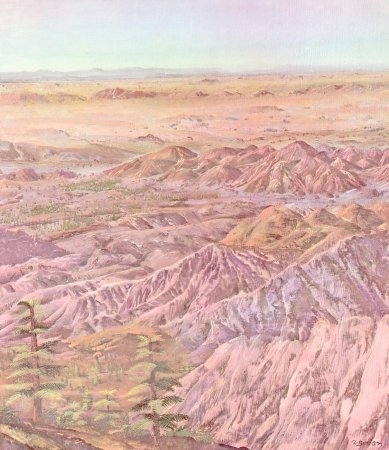 |
 |
The reproductive pattern of conifers has several important innovations for adaption to the dry environment. First, the gametophyte (haploid state) is not dependent on external moisture. The non-motile sperm are enclosed within the pollen grain and are delivered to the egg with the growth of the pollen tube. Therefore, fertilization does not require external water for swimming sperm. Second, the female gametophyte is protected from drying out by remaining within the ovule, which still is attached to the cone. Third, the immature sporophyte (diploid state) is dispersed by the seed, within which it is enclosed. The seed need not germinate until conditions are favorable to support growth (see Figure 19). |
Figure 18 Permian Plants [view large image] |
Figure 19 Conifer Life-cycle [view large image] |
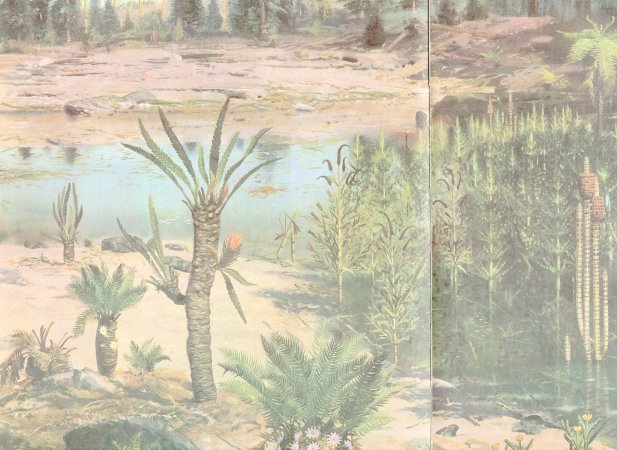 |
Earth's flora and fauna succumbed to the greatest of all extinctions around 245 MYA. About 95% of all species went extinct. It is estimated that biodiversity did not fully recover from this extinction for 25 million years. Figure 20 shows the cycads (left foreground), which had become the most important of the gymnosperm plants. They were either stumpy, with round or barrel-like stems, or had tall, slender trunks. All of them were topped by a tuft of palm-like leaves. Conifers were also becoming widely distributed. Another extinction occurred in the late Triassic, only 37 millions after the "big one". This one wiped out half the recovered and new species. |
Figure 20 Triassic Plants |
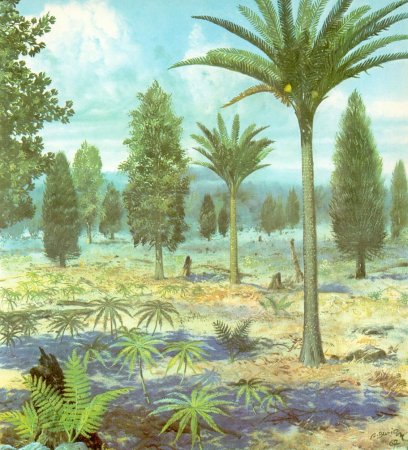 |
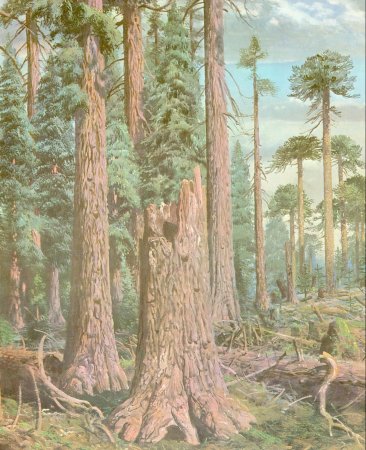 |
The Jurassic flora was tropical in character. Gymnosperms, mostly cycads, were the chief type of plant. Conifers and ginkgoes (of the same genus as the modern maidenhair tree) were also widespread. Part of the crown of a ginkgo, showing the deeply indented leaves, can be see on the left edge of Figure 21. Ginkgoales first appeared during the early Permian and became abundant in the Jurassic. Probably derived from cordaites, it shares a number of characteristics with cycads and other gymnosperms, and one species, Ginkgo Biloba, has survived as "living fossil" growing in China (now transplanted successfully all over the world). Figure 22 shows the forest of |
Figure 21 Jurassic Flora |
Figure 22 Jurassic Forest |
Jurassic times. It was filled with gymnosperms. Predominant among them were the tall, pointed ancestors of the sequoia, and a giant conifer that had a think trunk and luxuriant crown. |
 |
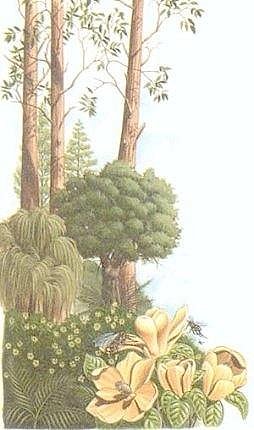 |
Angiosperms marked a higher evolutionary stage in plant development. Their seeds are enclosed in cases and they have specially developed sex organs (stamens and a pistil), which are usually surrounded by brightly coloured petals and a green calyx. These flowering plants probably originated at a time before the Cretaceous period. They quickly adopted to the cooler climate during the early Cretaceous, and after that they developed at an astonishing rate. By now gymnosperms were starting to decline. Some of them still persisted, but their numbers constantly diminished. The only gymnosperms remaining in large number were conifers, many species of which have survived down to the present. |
Figure 23 Cretaceous Plants |
Fig. 24 Flower-ing Plants [view large image] |
Figure 23 shows a typical Cretaceous scene of a forested area. Flowering plants (Figure 24) made true evolutionary history. Not only did they grow and reproduce faster than ferns, cycads and gymnosperms, but they also recovered more quickly after being trampled or munched on by animals. |
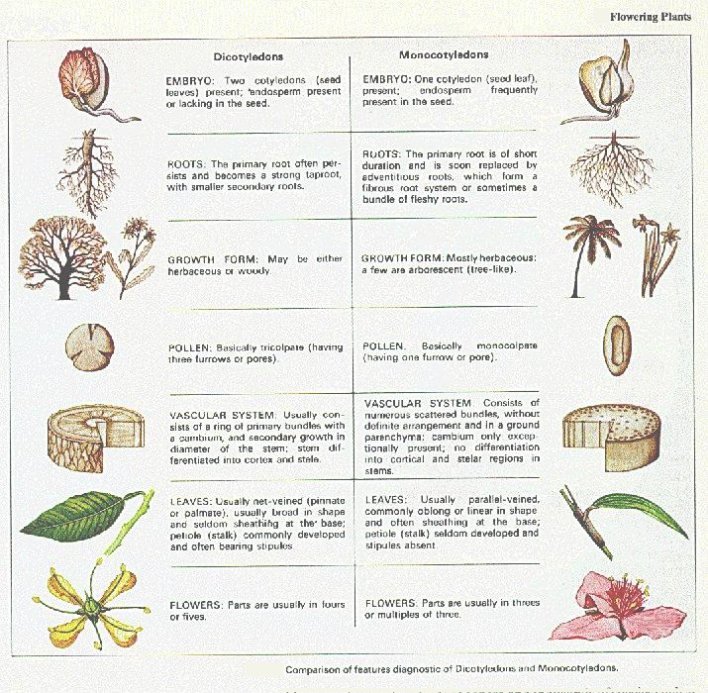 |
All hardwood trees, including all the deciduous trees of the temperate zone and broadleaved evergreen trees of the tropical zone, are angiosperms, although sometimes the flowers are inconspicuous. All herbaceous (nonwoody) plants common to our everyday experience, such as grasses and most garden plants, are flowering plants. Angiosperms are adapted to every type of habitat, including water. The angiosperms are divided into 2 classes: the monocots (e.g., lily) and the dicots (e.g., buttercup). The monocots are almost always herbaceous, with flower parts in multiple of three, parallel leaf veins, scattered vascular bundles in the stem, and one cotyledon, or seed leaf. The dicots are either woody or herbaceous and have flower part usually in fours and fives, net leaf veins, vascular bundles arranged in a circle within the stem, and two cotyledons, |
Fig. 25 Mono/Di-cots |
or seed leaves. Figure 25 compares the characteristics of these two classes. The reproductive cycle of the flowering plant is illustrated in Figure 10-32. The seeds are enclosed by fruit for protection. Many so-called vegetables are actually fruits, e.g., tomatoes, beans, and squash. Nuts, berries, and grains of wheat, rice, and oats are also fruits. |
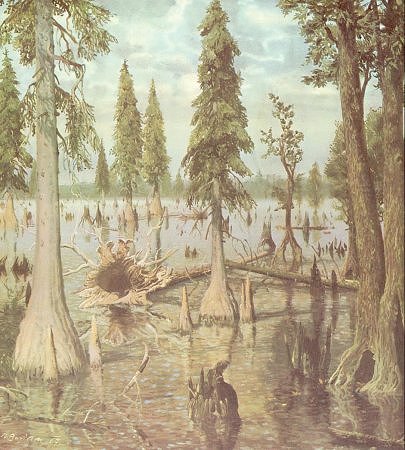 |
 |
Vast swampy forests were a marked feature of the Tertiary period, appearing in many of the low-lying land areas that emerged as a result of extensive mountain-folding. To give themselves additional support, conifers grew long prop roots, while the lower trunks of deciduous trees became cone-shaped (see Figure 26). As the original carbon-containing material of the forests became buried, it was subjected to enormous pressure. With the Tertiary swamp deposit, the carbonization process only went to the stage of lignite, or brown coal. This contains much less carbon than the earlier |
Fig. 26 Tertiary Plants |
Figure 27 Grassland |
Carboniferous deposits, which themselves vary in grade from bituminous (soft) coal to anthracite (hard coal). The appearance of grasses, which belongs to the angiosperm class of monocot, changed the Tertiary landscape as well as the diversity of animals. |
 |
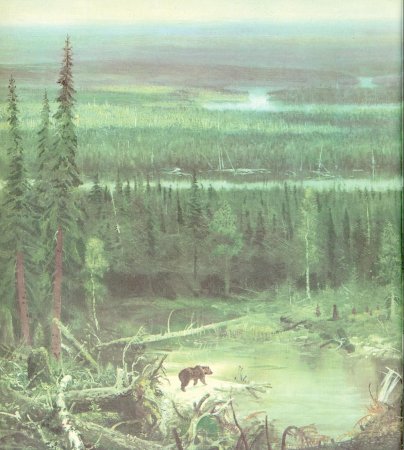 |
The Quaternary period saw the global temperature continue to fall, culminating in what is known as the Ice Age (see Figure 28). Actually there is not one Ice Age but a whole series of glacial periods (principally in the Northern Hemisphere) interspersed by warm, even tropical, inter-glacials. And even the glacial periods themselves are divided into colder phases and temperate interstitials. This marked climatic oscillation is superimposed on the long-term global cooling that began in the mid-Tertiary. The most recent cycle ended only about 12,000 |
Fig. 28 Ice Age |
Figure 29 Quaternary |
years ago. Plants in this period were basically modern flora, with successive communities according to climatic change. Figure 29 shows a landscape at the edge of the northern ice sheet. It contains conifers and deciduous trees. |